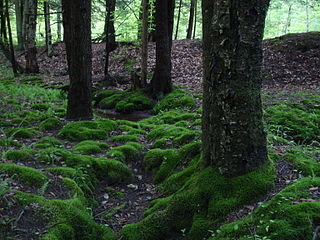
Mosses are small, non-vascular flowerless plants in the taxonomic division Bryophytasensu stricto. Bryophyta may also refer to the parent group bryophytes, which comprise liverworts, mosses, and hornworts. Mosses typically form dense green clumps or mats, often in damp or shady locations. The individual plants are usually composed of simple leaves that are generally only one cell thick, attached to a stem that may be branched or unbranched and has only a limited role in conducting water and nutrients. Although some species have conducting tissues, these are generally poorly developed and structurally different from similar tissue found in vascular plants. Mosses do not have seeds and after fertilisation develop sporophytes with unbranched stalks topped with single capsules containing spores. They are typically 0.2–10 cm (0.1–3.9 in) tall, though some species are much larger. Dawsonia, the tallest moss in the world, can grow to 50 cm (20 in) in height. There are approximately 12,000 species.
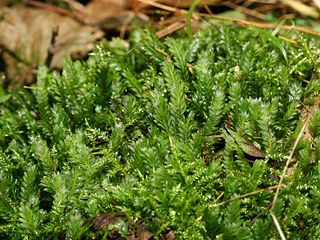
Fissidens adianthoides, the maidenhair pocketmoss, is a moss in the family Fissidentaceae. It was first collected by Hedwig in 1801.

Pleurozium schreberi, the red-stemmed feathermoss or Schreber's big red stem moss, is a moss with a loose growth pattern. The root name pleuro comes from the Latin for ribs, possibly describing how the parts branch from the stem.
Rhytidiadelphus triquetrus, the big shaggy-moss or rough goose neck moss, is a species of moss in the family Hylocomiaceae. It is often the dominating moss species in moderately rich forest habitats in the boreal regions and the Pacific Northwest. Because of its fuzzy appearance and tail-like shape it is also called the 'electrified cat's tail moss'. Not to be confused with square goose-necked moss, Rhytidiadelphus squarrosus.

Asulam is a herbicide invented by May & Baker Ltd, internally called M&B9057, that is used in horticulture and agriculture to kill bracken and docks. It is also used as an antiviral agent. It is currently marketed, by United Phosphorus Ltd - UPL, as "Asulox" which contains 400 g/L of asulam sodium salt.
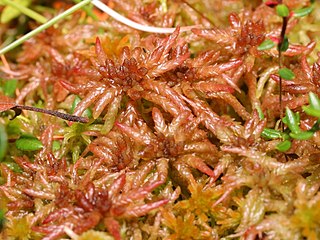
Sphagnum magellanicum, commonly called Magellanic bogmoss, Magellan's sphagnum, Magellan's peatmoss or midway peat moss, is a widespread species of moss found in wet boreal forest in the far south and southwest of South America, North America and Eurasia.
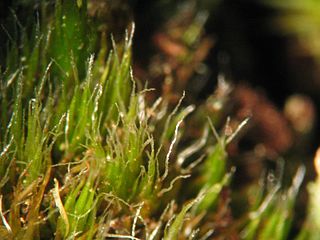
Campylopus introflexus, also known as the heath star moss, is a species of moss. The first description of the species was made by Johannes Hedwig as Dicranum introflexum in 1801.

Rhytidiadelphus squarrosus is a species of moss known as springy turf-moss in the United Kingdom, and square goose neck moss in the United States. It is widespread in Eurasia and North America, and has been introduced to the Southern Hemisphere. It has broad ecological tolerances, and is usually found in man-made habitats such as lawns and golf courses. It is most closely related to R. subpinnatus, with which it is often confused.
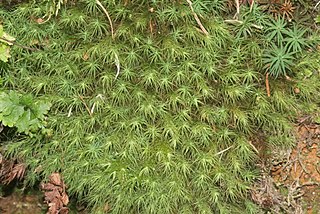
Bartramiales is an order of moss.
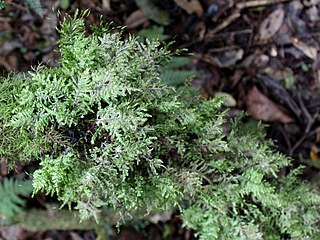
Eurhynchium praelongum is a species of moss with a widespread distribution. Found in Australia, New Zealand, North America, northern South America, Eurasia and North Africa .

Warnstorfia fluitans, the floating hook-moss or water hook-moss, is a species of moss found in acidic habitats across all continents except Antarctica.
Philonotis marchica is a species of moss belonging to the family Bartramiaceae.
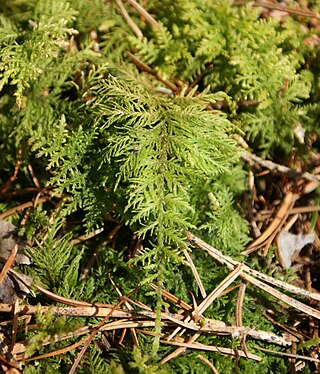
Thuidium tamariscinum is a species of moss belonging to the family Thuidiaceae. It has an almost cosmopolitan distribution.
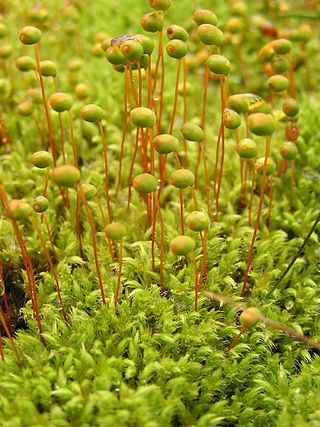
Bartramiaceae is a family of mosses belonging to the order Bartramiales.

Sphagnum contortum is a species of moss reported in North America and Europe. NatureServe marked its global conservation status as Secure.

Sphagnum denticulatum is a species of moss belonging to the family Sphagnaceae. It is widely distributed in Europe but it is also found in other parts of the world.
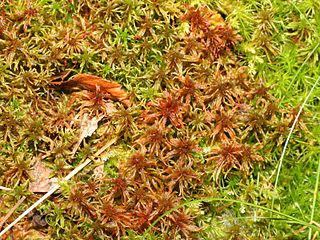
Sphagnum warnstorfii is a species of moss belonging to the family Sphagnaceae, named in honour of Carl Warnstorf. It is widely distributed in the north hemisphere.
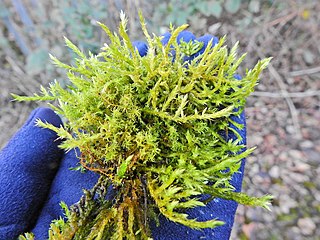
Calliergonella cuspidata is a species of moss belonging to the family Pylaisiaceae. It is widely distributed around the world.

Hypnum jutlandicum is a species of moss belonging to the family Hypnaceae. It is widely distributed in Europe and the Aleutian islands but it is also found in other parts of the world.

















